Fine-Grained Detection of Pavement Distress Based on Integrated Data Using Digital Twin
Abstract
1. Introduction
2. Related Work
2.1. Few-Shot Learning
2.2. Physics-Based Virtual Models
3. Methodology
3.1. Digital Twin-Based Generation of Integrated Dataset for Pavement Distress
3.1.1. On-Site Data Collection Based on UAV
3.1.2. Virtual Distress Rendering Based on a Lightweight Physics Engine
3.1.3. Integrated Dataset Generation with Different Virtual-to-Real Ratios
3.2. Fine-Grained Pavement Distress Detection Based on Deep-Object Detection Networks
3.2.1. Image Annotation
3.2.2. Deep Object Detection Network Construction
3.2.3. YOLOv5 Detector
3.2.4. Overall Loss
4. Experiment
4.1. Experimental Environment and Hyperparameters
4.2. Evaluation Metrics
5. Results and Discussion
5.1. Model Comparison
5.2. Comparison of the Results for Different Virtual-to-Real Ratios
5.3. Comparison of Results for Different Detection Scenarios
5.4. Comparison of Results for Different Pavement Texture Conditions
6. Conclusions
Author Contributions
Funding
Institutional Review Board Statement
Informed Consent Statement
Data Availability Statement
Conflicts of Interest
References
- Ceravolo, R.; Miraglia, G.; Surace, C.; Fragonara, L.Z. A Computational Methodology for Assessing the Time-Dependent Structural Performance of Electric Road Infrastructures. Comput. Civ. Infrastruct. Eng. 2016, 31, 701–716. [Google Scholar] [CrossRef]
- Qiao, Y.; Dawson, A.; Huvstig, A.; Korkiala-Tanttu, L. Calculating rutting of some thin flexible pavements from repeated load triaxial test data. Int. J. Pavement Eng. 2015, 16, 467–476. [Google Scholar] [CrossRef]
- Jia, Y.; Wang, S.; Huang, A.; Gao, Y.; Wang, J.; Zhou, W. A comparative long-term effectiveness assessment of preventive maintenance treatments under various environmental conditions. Constr. Build. Mater. 2021, 273, 121717. [Google Scholar] [CrossRef]
- Cao, W.; Liu, Q.; He, Z. Review of Pavement Defect Detection Methods. IEEE Access 2020, 8, 14531–14544. [Google Scholar] [CrossRef]
- Ai, D.; Jiang, G.; Lam, S.-K.; He, P.; Li, C. Computer vision framework for crack detection of civil infrastructure—A review. Eng. Appl. Artif. Intell. 2023, 117, 105478. [Google Scholar] [CrossRef]
- Du, Z.; Yuan, J.; Xiao, F.; Hettiarachchi, C. Application of image technology on pavement distress detection: A review. Measurement 2021, 184, 109900. [Google Scholar] [CrossRef]
- Hu, W.; Wang, W.; Ai, C.; Wang, J.; Wang, W.; Meng, X.; Liu, J.; Tao, H.; Qiu, S. Machine vision-based surface crack analysis for transportation infrastructure. Autom. Constr. 2021, 132, 103973. [Google Scholar] [CrossRef]
- Gopalakrishnan, K.; Khaitan, S.K.; Choudhary, A.; Agrawal, A. Deep Convolutional Neural Networks with transfer learning for computer vision-based data-driven pavement distress detection. Constr. Build. Mater. 2017, 157, 322–330. [Google Scholar] [CrossRef]
- Hoang, N.-D.; Nguyen, Q.-L. A novel method for asphalt pavement crack classification based on image processing and machine learning. Eng. Comput. 2018, 35, 487–498. [Google Scholar] [CrossRef]
- Zhou, Y.; Wang, F.; Meghanathan, N.; Huang, Y. Seed-Based Approach for Automated Crack Detection from Pavement Images. Transp. Res. Rec. 2016, 2589, 162–171. [Google Scholar] [CrossRef]
- Li, Q.; Zou, Q.; Zhang, D.; Mao, Q. FoSA: F* Seed-growing Approach for crack-line detection from pavement images. Image Vis. Comput. 2011, 29, 861–872. [Google Scholar] [CrossRef]
- Tsai, Y.C.; Chatterjee, A. Pothole Detection and Classification Using 3D Technology and Watershed Method. J. Comput. Civ. Eng. 2018, 32, 04017078. [Google Scholar] [CrossRef]
- Dorafshan, S.; Thomas, R.J.; Maguire, M. Comparison of deep convolutional neural networks and edge detectors for image-based crack detection in concrete. Constr. Build. Mater. 2018, 186, 1031–1045. [Google Scholar] [CrossRef]
- Shi, Y.; Cui, L.; Qi, Z.; Meng, F.; Chen, Z. Automatic Road Crack Detection Using Random Structured Forests. IEEE Trans. Intell. Transp. Syst. 2016, 17, 3434–3445. [Google Scholar] [CrossRef]
- Huyan, J.; Li, W.; Tighe, S.; Deng, R.; Yan, S. Illumination Compensation Model with k -Means Algorithm for Detection of Pavement Surface Cracks with Shadow. J. Comput. Civ. Eng. 2020, 34. [Google Scholar] [CrossRef]
- Li, H.; Song, D.; Liu, Y.; Li, B. Automatic Pavement Crack Detection by Multi-Scale Image Fusion. IEEE Trans. Intell. Transp. Syst. 2018, 20, 2025–2036. [Google Scholar] [CrossRef]
- Eidgahee, D.R.; Jahangir, H.; Solatifar, N.; Fakharian, P.; Rezaeemanesh, M. Data-driven estimation models of asphalt mixtures dynamic modulus using ANN, GP and combinatorial GMDH approaches. Neural Comput. Appl. 2022, 34, 17289–17314. [Google Scholar] [CrossRef]
- Xu, G.; Ma, J.; Liu, F.; Niu, X. Automatic Recognition of Pavement Surface Crack Based on BP Neural Network. In Proceedings of the 2008 International Conference on Computer and Electrical Engineering, Phuket, Thailand, 20–22 December 2008; IEEE: Piscataway, NJ, USA, 2008; pp. 19–22. [Google Scholar] [CrossRef]
- Wang, S.; Qiu, S.; Wang, W.; Xiao, D.; Wang, K.C.P. Cracking Classification Using Minimum Rectangular Cover–Based Support Vector Machine. J. Comput. Civ. Eng. 2017, 31, 04017027. [Google Scholar] [CrossRef]
- Cha, Y.-J.; Choi, W.; Büyüköztürk, O. Deep Learning-Based Crack Damage Detection Using Convolutional Neural Networks. Comput. Civ. Infrastruct. Eng. 2017, 32, 361–378. [Google Scholar] [CrossRef]
- Wang, W.; Hu, W.; Wang, W.; Xu, X.; Wang, M.; Shi, Y.; Qiu, S.; Tutumluer, E. Automated crack severity level detection and classification for ballastless track slab using deep convolutional neural network. Autom. Constr. 2021, 124, 103484. [Google Scholar] [CrossRef]
- Hou, Y.; Li, Q.; Han, Q.; Peng, B.; Wang, L.; Gu, X.; Wang, D. MobileCrack: Object Classification in Asphalt Pavements Using an Adaptive Lightweight Deep Learning. J. Transp. Eng. Part B Pavements 2021, 147, 04020092. [Google Scholar] [CrossRef]
- Song, L.; Wang, X. Faster region convolutional neural network for automated pavement distress detection. Road Mater. Pavement Des. 2019, 22, 23–41. [Google Scholar] [CrossRef]
- Mandal, V.; Uong, L.; Adu-Gyamfi, Y. Automated road crack detection using deep convolutional neural networks. In Proceedings of the 2018 IEEE International Conference on Big Data (Big Data), Seattle, WA, USA, 10–13 December 2018; pp. 5212–5215. [Google Scholar] [CrossRef]
- Zhang, L.; Yang, F.; Zhang, Y.D.; Zhu, Y.J. Road crack detection using deep convolutional neural network. In Proceedings of the 2016 IEEE International Conference on Image Processing, ICIP, Phoenix, AZ, USA, 25–28 September 2016; IEEE: Piscataway, NJ, USA, 2016; pp. 3708–3712. [Google Scholar] [CrossRef]
- Nhat-Duc, H.; Nguyen, Q.-L.; Tran, V.-D. Automatic recognition of asphalt pavement cracks using metaheuristic optimized edge detection algorithms and convolution neural network. Autom. Constr. 2018, 94, 203–213. [Google Scholar] [CrossRef]
- Zhang, K.; Cheng, H.D.; Zhang, B. Unified Approach to Pavement Crack and Sealed Crack Detection Using Preclassification Based on Transfer Learning. J. Comput. Civ. Eng. 2018, 32, 04018001. [Google Scholar] [CrossRef]
- Rajadurai, R.-S.; Kang, S.-T. Automated Vision-Based Crack Detection on Concrete Surfaces Using Deep Learning. Appl. Sci. 2021, 11, 5229. [Google Scholar] [CrossRef]
- Xiao, S.; Shang, K.; Lin, K.; Wu, Q.; Gu, H.; Zhang, Z. Pavement crack detection with hybrid-window attentive vision transformers. Int. J. Appl. Earth Obs. Geoinf. 2023, 116, 103172. [Google Scholar] [CrossRef]
- Zhang, A.; Wang, K.C.P.; Li, B.; Yang, E.; Dai, X.; Peng, Y.; Fei, Y.; Liu, Y.; Li, J.Q.; Chen, C. Automated Pixel-Level Pavement Crack Detection on 3D Asphalt Surfaces Using a Deep-Learning Network. Comput. Aided Civ. Infrastruct. Eng. 2017, 32, 805–819. [Google Scholar] [CrossRef]
- Zhu, J.; Zhong, J.; Ma, T.; Huang, X.; Zhang, W.; Zhou, Y. Pavement distress detection using convolutional neural networks with images captured via UAV. Autom. Constr. 2021, 133, 103991. [Google Scholar] [CrossRef]
- Kim, I.-H.; Jeon, H.; Baek, S.-C.; Hong, W.-H.; Jung, H.-J. Application of Crack Identification Techniques for an Aging Concrete Bridge Inspection Using an Unmanned Aerial Vehicle. Sensors 2018, 18, 1881. [Google Scholar] [CrossRef]
- Li, Y.; Ma, J.; Zhao, Z.; Shi, G. A Novel Approach for UAV Image Crack Detection. Sensors 2022, 22, 3305. [Google Scholar] [CrossRef]
- Liu, J.; Zhao, Z.; Lv, C.; Ding, Y.; Chang, H.; Xie, Q. An image enhancement algorithm to improve road tunnel crack transfer detection. Constr. Build. Mater. 2022, 348, 128583. [Google Scholar] [CrossRef]
- Hou, Y.; Li, Q.; Zhang, C.; Lu, G.; Ye, Z.; Chen, Y.; Wang, L.; Cao, D. The State-of-the-Art Review on Applications of Intrusive Sensing, Image Processing Techniques, and Machine Learning Methods in Pavement Monitoring and Analysis. Engineering 2020, 7, 845–856. [Google Scholar] [CrossRef]
- Spencer, B.F., Jr.; Hoskere, V.; Narazaki, Y. Advances in Computer Vision-Based Civil Infrastructure Inspection and Monitoring. Engineering 2019, 5, 199–222. [Google Scholar] [CrossRef]
- Subedi, B.; Sathishkumar, V.E.; Maheshwari, V.; Kumar, M.S.; Jayagopal, P.; Allayear, S.M. Feature Learning-Based Generative Adversarial Network Data Augmentation for Class-Based Few-Shot Learning. Math. Probl. Eng. 2022, 2022, 9710667. [Google Scholar] [CrossRef]
- Chen, C.; Li, K.; Wei, W.; Zhou, J.T.; Zeng, Z. Hierarchical Graph Neural Networks for Few-Shot Learning. IEEE Trans. Circuits Syst. Video Technol. 2021, 32, 240–252. [Google Scholar] [CrossRef]
- Wu, S.; Fang, J.; Zheng, X.; Li, X. Sample and Structure-Guided Network for Road Crack Detection. IEEE Access 2019, 7, 130032–130043. [Google Scholar] [CrossRef]
- Duan, Y.Q.; Zheng, W.Z.; Lin, X.D.; Lu, J.W.; Zhou, J. Deep adversarial metric learning. In Proceedings of the IEEE Conference on Computer Vision and Pattern Recognition, Long Beach, CA, USA, 25 October 2019; pp. 2780–2789. [Google Scholar] [CrossRef]
- Wang, J.; Zou, Y.S.; Lei, P.; Sherratt, R.S.; Wang, L. Research on recurrent neural network based crack opening prediction of concrete dam. J. Internet Technol. 2020, 21, 1161–1169. [Google Scholar] [CrossRef]
- Dong, H.; Song, K.; Wang, Q.; Yan, Y.; Jiang, P. Deep Metric Learning-Based for Multi-Target Few-Shot Pavement Distress Classification. IEEE Trans. Ind. Inform. 2021, 18, 1801–1810. [Google Scholar] [CrossRef]
- Xu, Y.; Bao, Y.; Zhang, Y.; Li, H. Attribute-based structural damage identification by few-shot meta learning with inter-class knowledge transfer. Struct. Health Monit. 2020, 20, 1494–1517. [Google Scholar] [CrossRef]
- Hoskere, V.; Narazaki, Y.; Spencer, B.F.; Smith, M.D. Deep Learning-based Damage Detection of Miter Gates Using Synthetic Imagery from Computer Graphics. In Proceedings of the 12th International Workshop on Structural Health Monitoring: Enabling Intelligent Life-Cycle Health Management for Industry Internet of Things (IIOT), Stanford, CA, USA, 10–12 September 2019; pp. 3073–3080. [Google Scholar] [CrossRef]
- Hoskere, V.; Narazaki, Y.; Spencer, B.F. Learning to detect important visual changes for structural inspections using phys-icsbased graphics models. In Proceedings of the 9th International Conference on Structural Health Monitoring of Intelligent Infrastructure (ISHMII), St. Louis, MI, USA, 4–7 August 2019; pp. 1484–1490. Available online: http://www.scopus.com/inward/record.url?scp=85090588897&partnerID=8YFLogxK (accessed on 1 January 2019).
- Pyle, R.J.; Bevan, R.L.T.; Hughes, R.R.; Rachev, R.K.; Ali, A.A.S.; Wilcox, P.D. Deep Learning for Ultrasonic Crack Characterization in NDE. IEEE Trans. Ultrason. Ferroelectr. Freq. Control 2020, 68, 1854–1865. [Google Scholar] [CrossRef]
- Hakim, S.; Razak, H.A.; Ravanfar, S. Fault diagnosis on beam-like structures from modal parameters using artificial neural networks. Measurement 2015, 76, 45–61. [Google Scholar] [CrossRef]
- Siu, C.; Wang, M.; Cheng, J.C. A framework for synthetic image generation and augmentation for improving automatic sewer pipe defect detection. Autom. Constr. 2022, 137, 104213. [Google Scholar] [CrossRef]
- Xu, Y.; Huang, B.; Luo, X.; Bradbury, K.; Malof, J.M. SIMPL: Generating Synthetic Overhead Imagery to Address Custom Zero-Shot and Few-Shot Detection Problems. IEEE J. Sel. Top. Appl. Earth Obs. Remote Sens. 2022, 15, 4386–4396. [Google Scholar] [CrossRef]
- Richter, S.R.; Vineet, V.; Roth, S.; Koltun, V. Playing for Data: Ground Truth from Computer Games. In Proceedings of the Computer Vision–ECCV 2016: 14th European Conference, Amsterdam, The Netherlands, 11–14 October 2016; Springer International: Berlin/Heidelberg, Germany, 2016; pp. 102–118. [Google Scholar] [CrossRef]
- Zhang, Y.; Song, S.; Yumer, E.; Savva, M.; Lee, J.-Y.; Jin, H.; Funkhouser, T. Physically-Based Rendering for Indoor Scene Understanding Using Convolutional Neural Networks. In Proceedings of the 2017 IEEE Conference on Computer Vision and Pattern Recognition (CVPR), Honolulu, HI, USA, 21–26 July 2017; pp. 5287–5295. [Google Scholar] [CrossRef]
- Tobin, J.; Fong, R.; Ray, A.; Schneider, J.; Zaremba, W.; Abbeel, P. Domain randomization for transferring deep neural networks from simulation to the real world. In Proceedings of the 2017 IEEE/RSJ International Conference on Intelligent Robots and Systems (IROS), Vancouver, BC, Canada, 24–28 September 2017; IEEE: Piscataway, NJ, USA, 2017; pp. 23–30. [Google Scholar] [CrossRef]
- Jiang, F.; Ma, L.; Broyd, T.; Chen, K. Digital twin and its implementations in the civil engineering sector. Autom. Constr. 2021, 130, 103838. [Google Scholar] [CrossRef]
- Ritto, T.; Rochinha, F. Digital twin, physics-based model, and machine learning applied to damage detection in structures. Mech. Syst. Signal Process. 2021, 155, 107614. [Google Scholar] [CrossRef]
- Tuegel, E.; Ingraffea, A.R.; Eason, T.G.; Spottswood, S.M. Reengineering Aircraft Structural Life Prediction Using a Digital Twin. Int. J. Aerosp. Eng. 2011, 2011, 154798. [Google Scholar] [CrossRef]
- Shim, C.-S.; Dang, N.-S.; Lon, S.; Jeon, C.-H. Development of a bridge maintenance system for prestressed concrete bridges using 3D digital twin model. Struct. Infrastruct. Eng. 2019, 15, 1319–1332. [Google Scholar] [CrossRef]
- Karve, P.M.; Guo, Y.; Kapusuzoglu, B.; Mahadevan, S.; Haile, M.A. Digital twin approach for damage-tolerant mission planning under uncertainty. Eng. Fract. Mech. 2019, 225, 106766. [Google Scholar] [CrossRef]
- Booyse, W.; Wilke, D.N.; Heyns, S. Deep digital twins for detection, diagnostics and prognostics. Mech. Syst. Signal Process. 2020, 140, 106612. [Google Scholar] [CrossRef]
- Aivaliotis, P.; Georgoulias, K.; Alexopoulos, K. Using digital twin for maintenance applications in manufacturing: State of the Art and Gap analysis. In Proceedings of the 2019 IEEE International Conference on Engineering, Technology and Innovation (ICE/ITMC), Valbonne Sophia-Antipolis, France, 17–19 June 2019. [Google Scholar] [CrossRef]
- Redmon, J.; Divvala, S.; Girshick, R.; Farhadi, A. You Only Look Once: Unified, Real-Time Object Detection. In Proceedings of the 2016 IEEE Conference on Computer Vision and Pattern Recognition (CVPR), Las Vegas, NV, USA, 27–30 June 2016; pp. 779–788. [Google Scholar] [CrossRef]
- Bochkovskiy, A.; Wang, C.; Liao, H. YOLOv4: Optimal Speed and Accuracy of Object Detection. arXiv 2020, arXiv:2004.10934. [Google Scholar] [CrossRef]
- Ren, S.; He, K.; Girshick, R.; Sun, J. Faster R-CNN: Towards real-time object detection with region proposal networks. IEEE Trans. Pattern Anal. Mach. Intell. 2017, 39, 1137–1149. [Google Scholar] [CrossRef]
- Wang, H.; Zhang, S.; Zhao, S.; Wang, Q.; Li, D.; Zhao, R. Real-time detection and tracking of fish abnormal behavior based on improved YOLOV5 and SiamRPN++. Comput. Electron. Agric. 2021, 192, 106512. [Google Scholar] [CrossRef]
- Li, Z.; Lu, K.; Zhang, Y.; Li, Z.; Liu, J.-B. Research on Energy Efficiency Management of Forklift Based on Improved YOLOv5 Algorithm. J. Math. 2021, 2021, 5808221. [Google Scholar] [CrossRef]
- Wang, C.-Y.; Liao, H.-Y.M.; Wu, Y.-H.; Chen, P.-Y.; Hsieh, J.-W.; Yeh, I.-H. CSPNet: A New Backbone that can Enhance Learning Capability of CNN. In Proceedings of the 2020 IEEE/CVF Conference on Computer Vision and Pattern Recognition Workshops (CVPRW), Seattle, WA, USA, 14–19 June 2020; pp. 1571–1580. [Google Scholar]
- Redmon, J.; Farhadi, A. YOLOv3: An Incremental Improvement. arXiv 2018, arXiv:1804.02767. [Google Scholar] [CrossRef]
- Li, S.; Li, Y.; Li, Y.; Li, M.; Xu, X. YOLO-FIRI: Improved YOLOv5 for Infrared Image Object Detection. IEEE Access 2021, 9, 141861–141875. [Google Scholar] [CrossRef]
- Lin, T.Y.; Dollár, P.; Girshick, R.; He, K.; Hariharan, B.; Belongie, S. Feature pyramid networks for object detection. In Proceedings of the IEEE Conference on Computer Vision and Pattern Recognition, Honolulu, HI, USA, 21–26 July 2017; pp. 2117–2125. [Google Scholar] [CrossRef]
- Liu, S.; Qi, L.; Qin, H.; Shi, J.; Jia, J. Path Aggregation Network for Instance Segmentation. In Proceedings of the 2018, IEEE/CVF Conference on Computer Vision and Pattern Recognition (CVPR), Salt Lake City, UT, USA, 18–23 June 2018; pp. 8759–8768. [Google Scholar] [CrossRef]
- Yu, J.H.; Jiang, Y.N.; Wang, Z.Y.; Cao, Z.; Huang, T. UnitBox: An Advanced Object Detection Network. arXiv 2016, arXiv:1608.01471. [Google Scholar] [CrossRef]
- Zheng, Z.; Wang, P.; Liu, W.; Li, J.; Ye, R.; Ren, D. Distance-IoU Loss: Faster and Better Learning for Bounding Box Regression. In Proceedings of the AAAI Conference on Artificial Intelligence, New York, NY, USA, 7–12 February 2020; Volume 34, pp. 12993–13000. [Google Scholar]
- Li, Y.; Li, J.; Zhang, M. Deep Transformer modeling via grouping skip connection for neural machine translation. Knowl. Based Syst. 2021, 234, 107556. [Google Scholar] [CrossRef]
- Gu, Y.; Piao, Z.; Yoo, S.J. STHarDNet: Swin Transformer with HarDNet for MRI Segmentation. Appl. Sci. 2022, 12, 468. [Google Scholar] [CrossRef]
- Mary, N.J.M.S.; Umesh, S.; Katta, S.V. S-vectors and TESA: Speaker embeddings and a speaker authenticator based on transformer encoder. IEEE/ACM Trans. Audio Speech Lang. Process. 2021, 30, 404–413. [Google Scholar] [CrossRef]
- Huang, Y.Y.; Si, Y.; Hu, B.L.; Zhang, Y.; Wu, S.; Wu, D.S.; Wang, Q. Transformer-based factorized encoder for classification of pneumoconiosis on 3D CT images. Comput. Biol. Med. 2022, 150, 106137. [Google Scholar] [CrossRef]
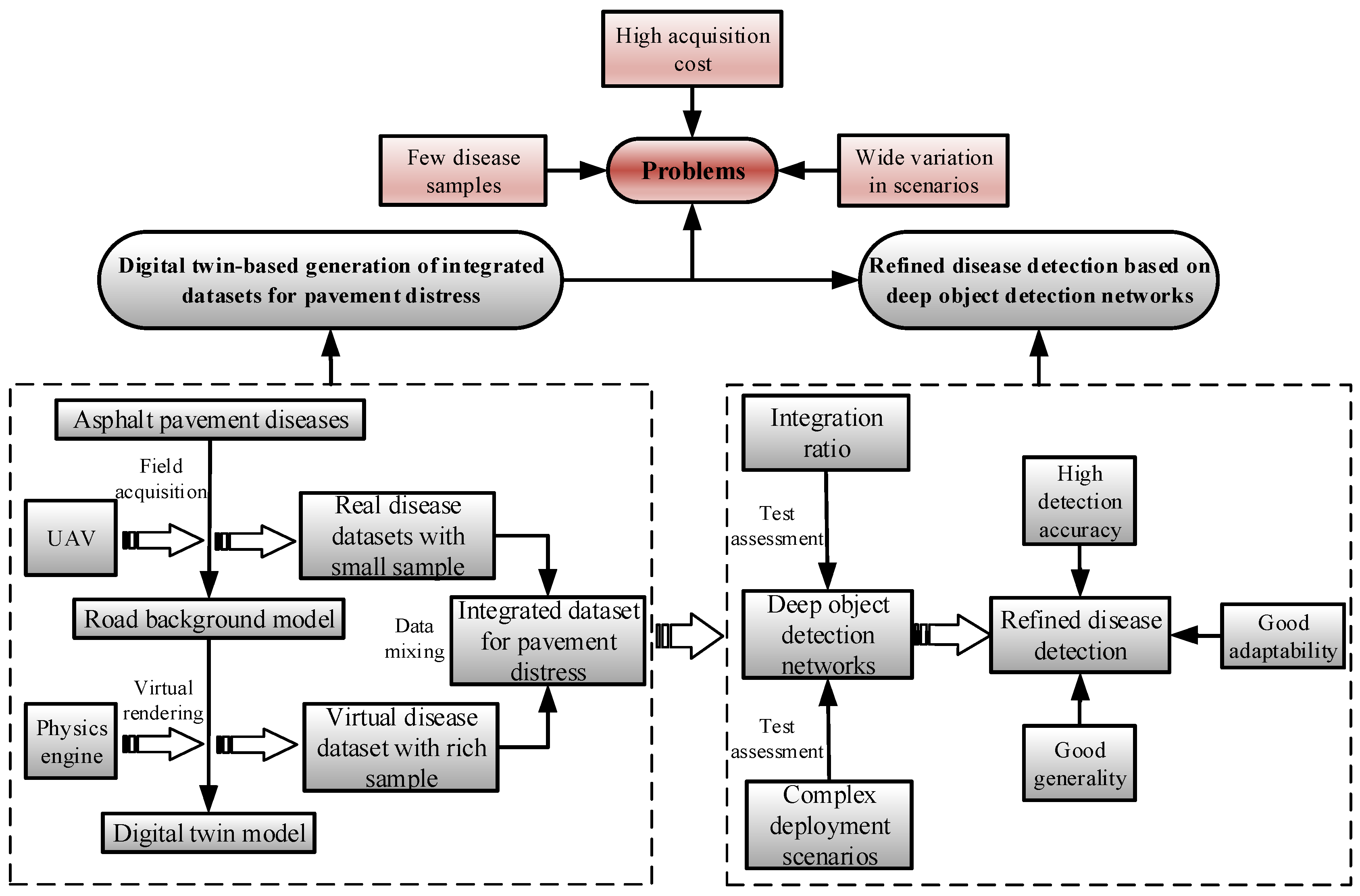
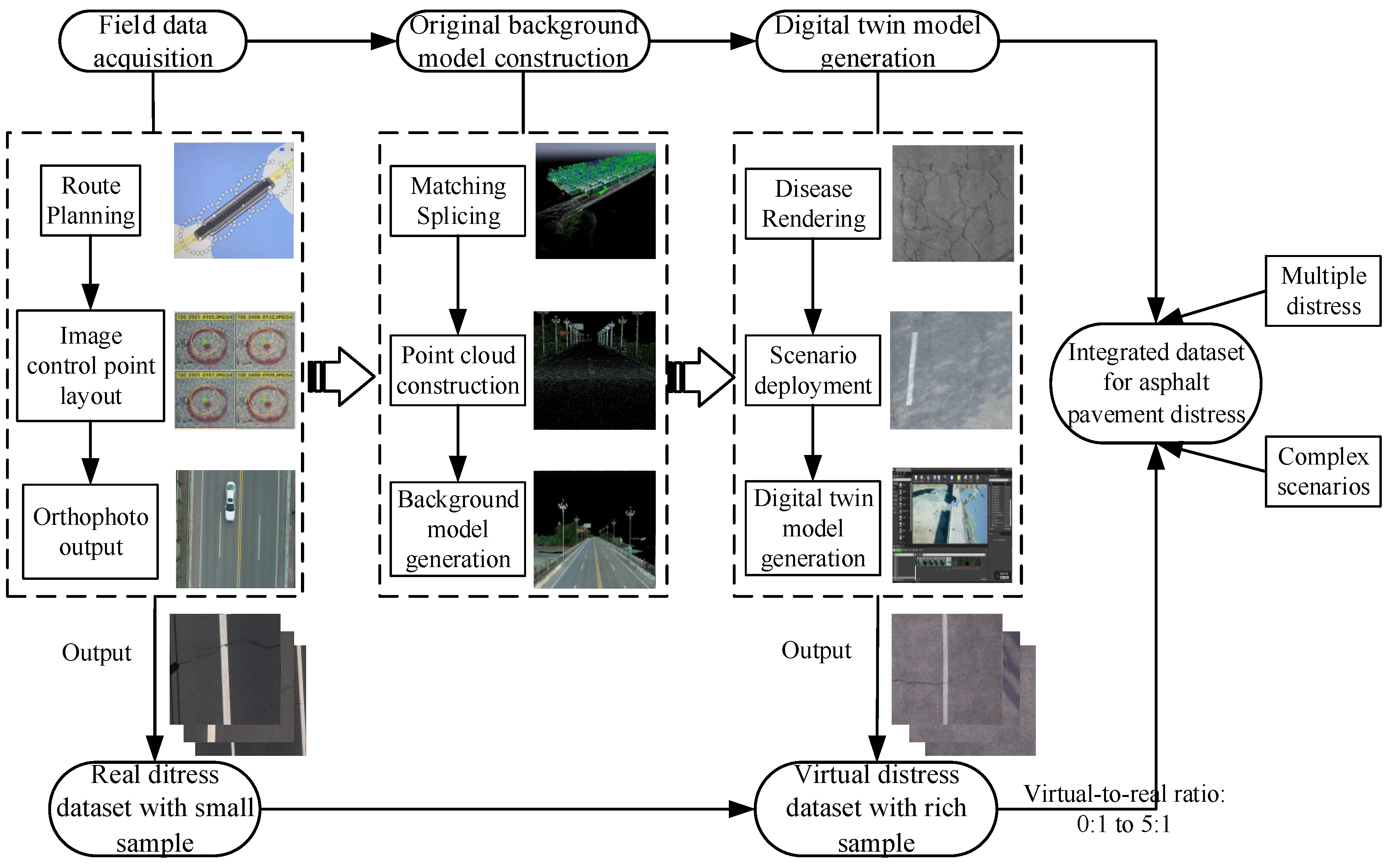
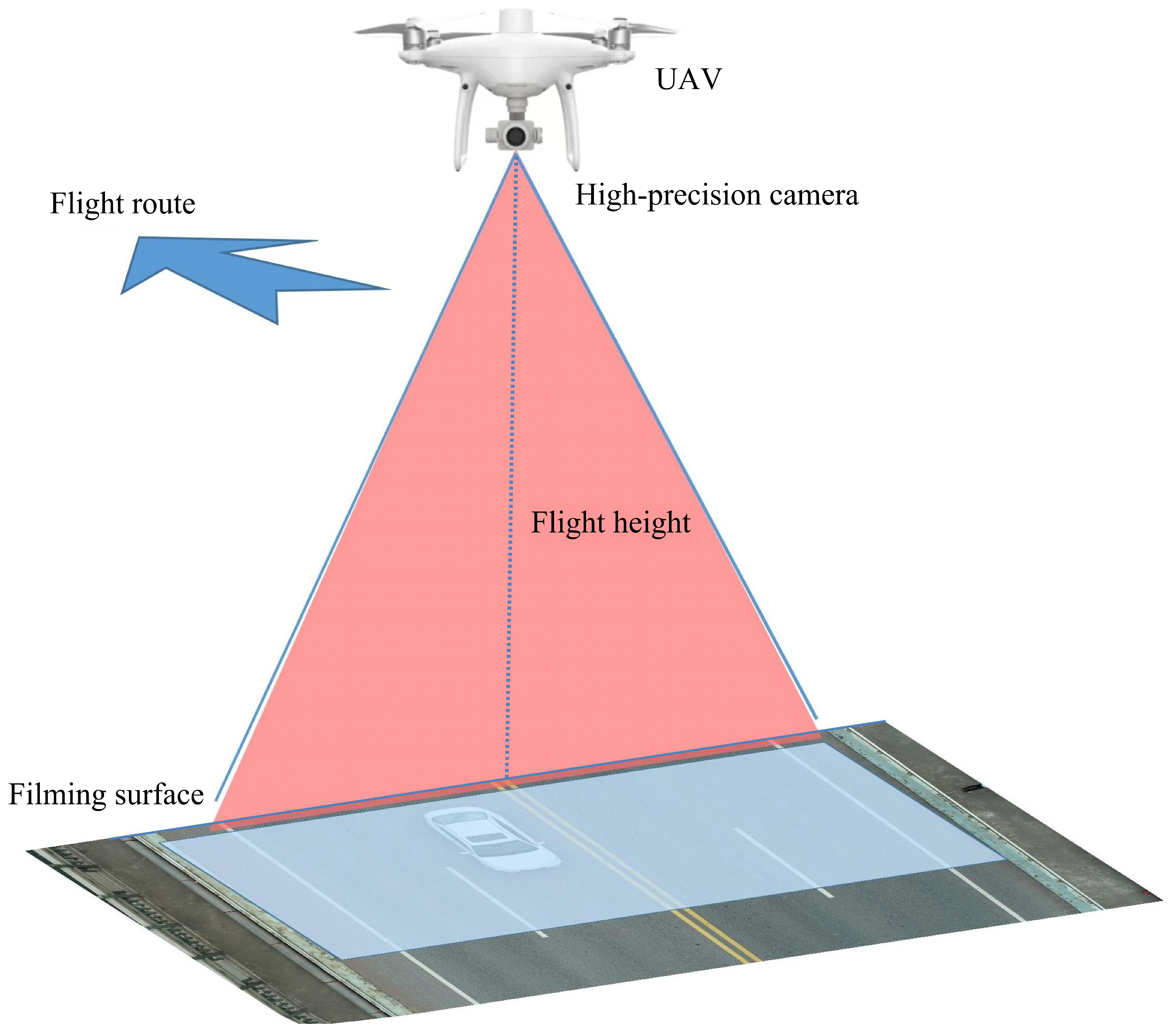


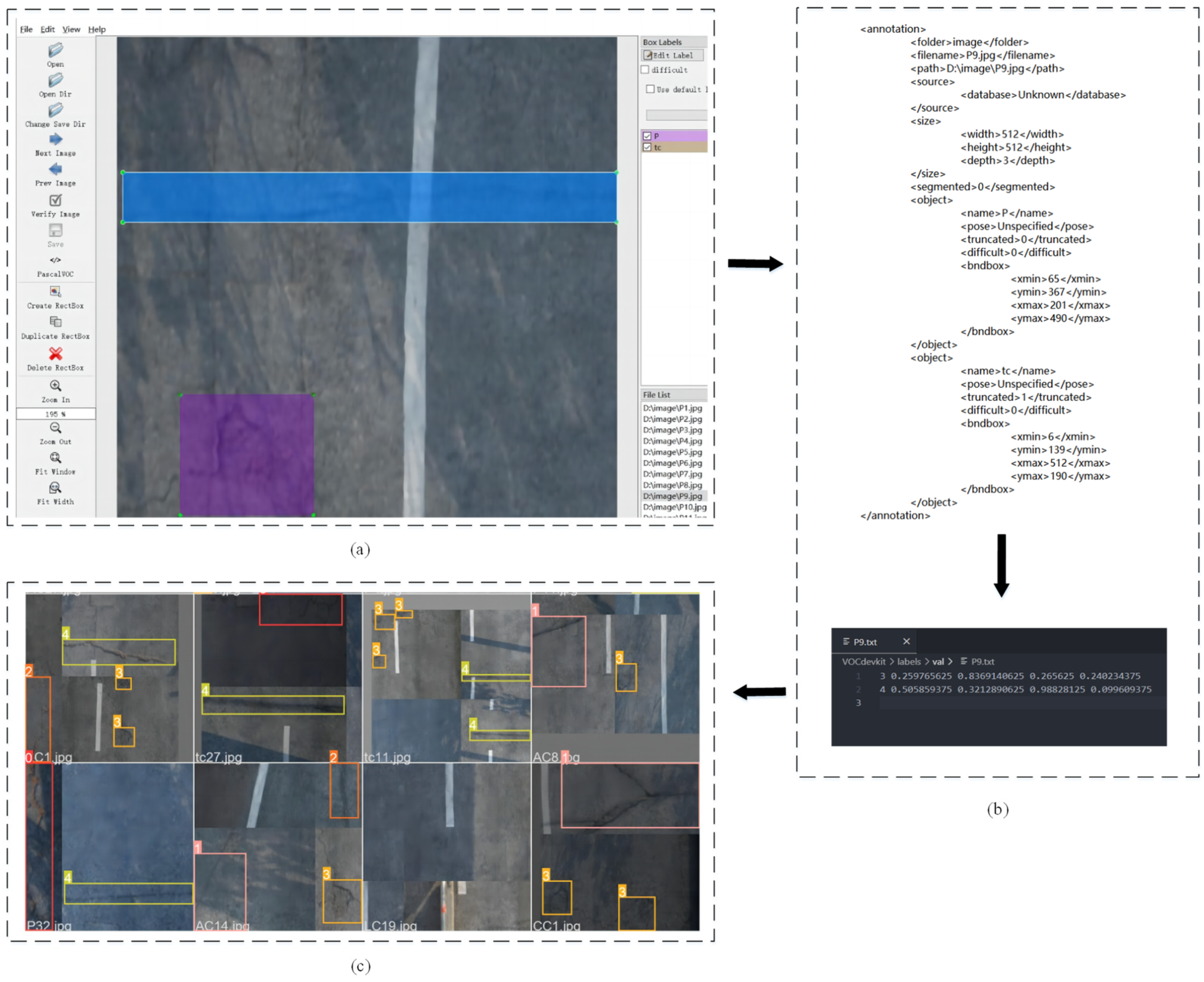


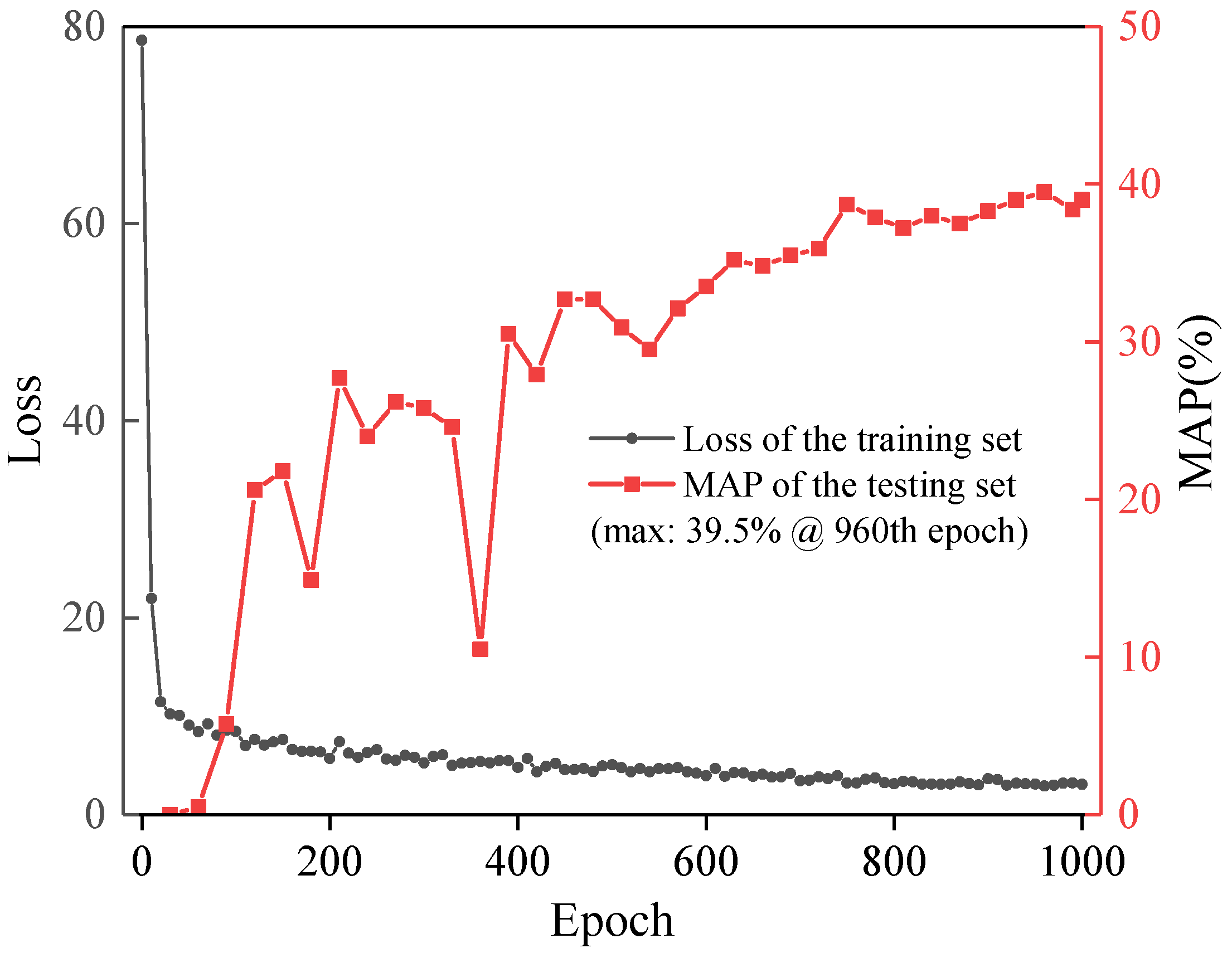
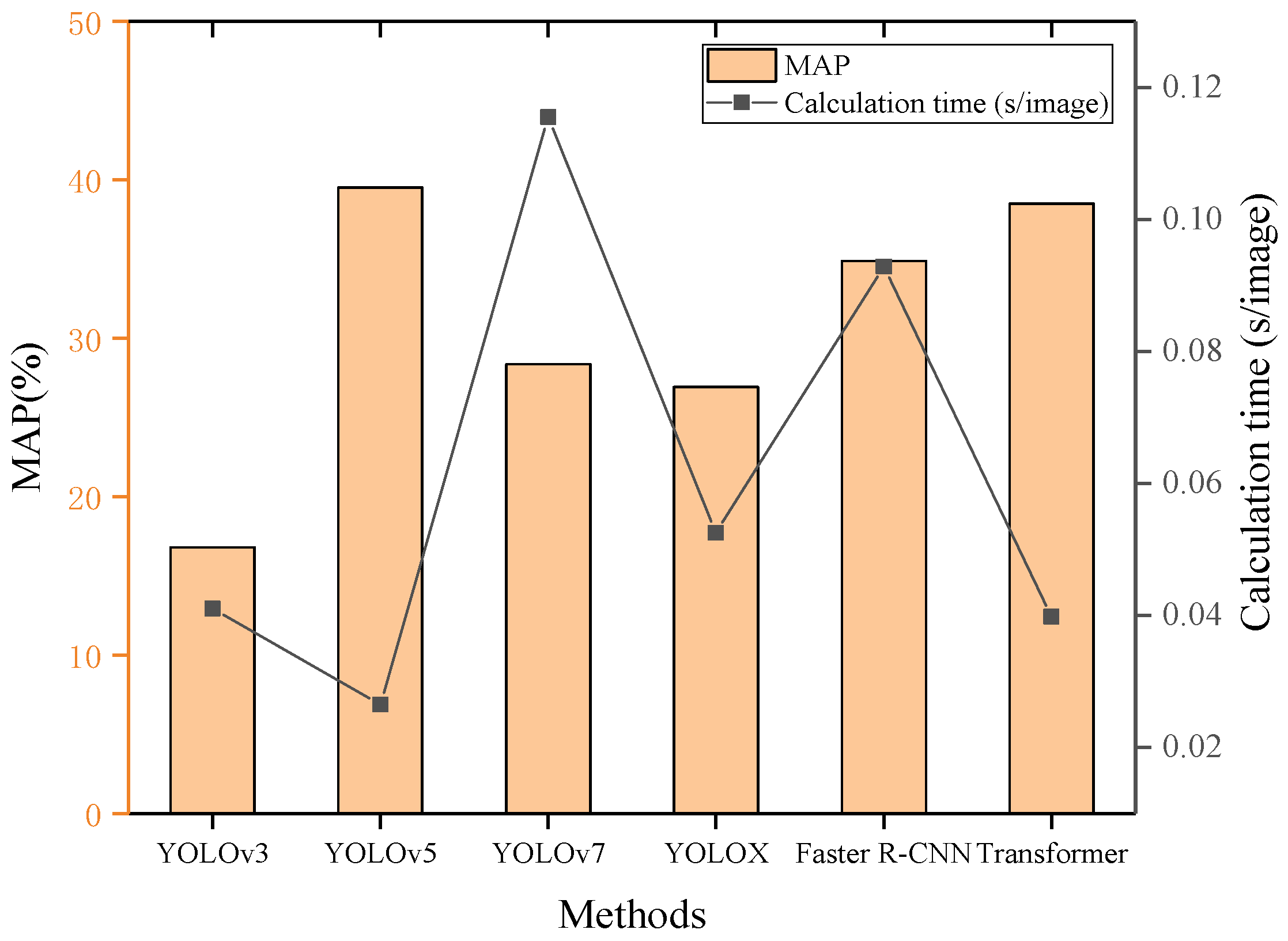

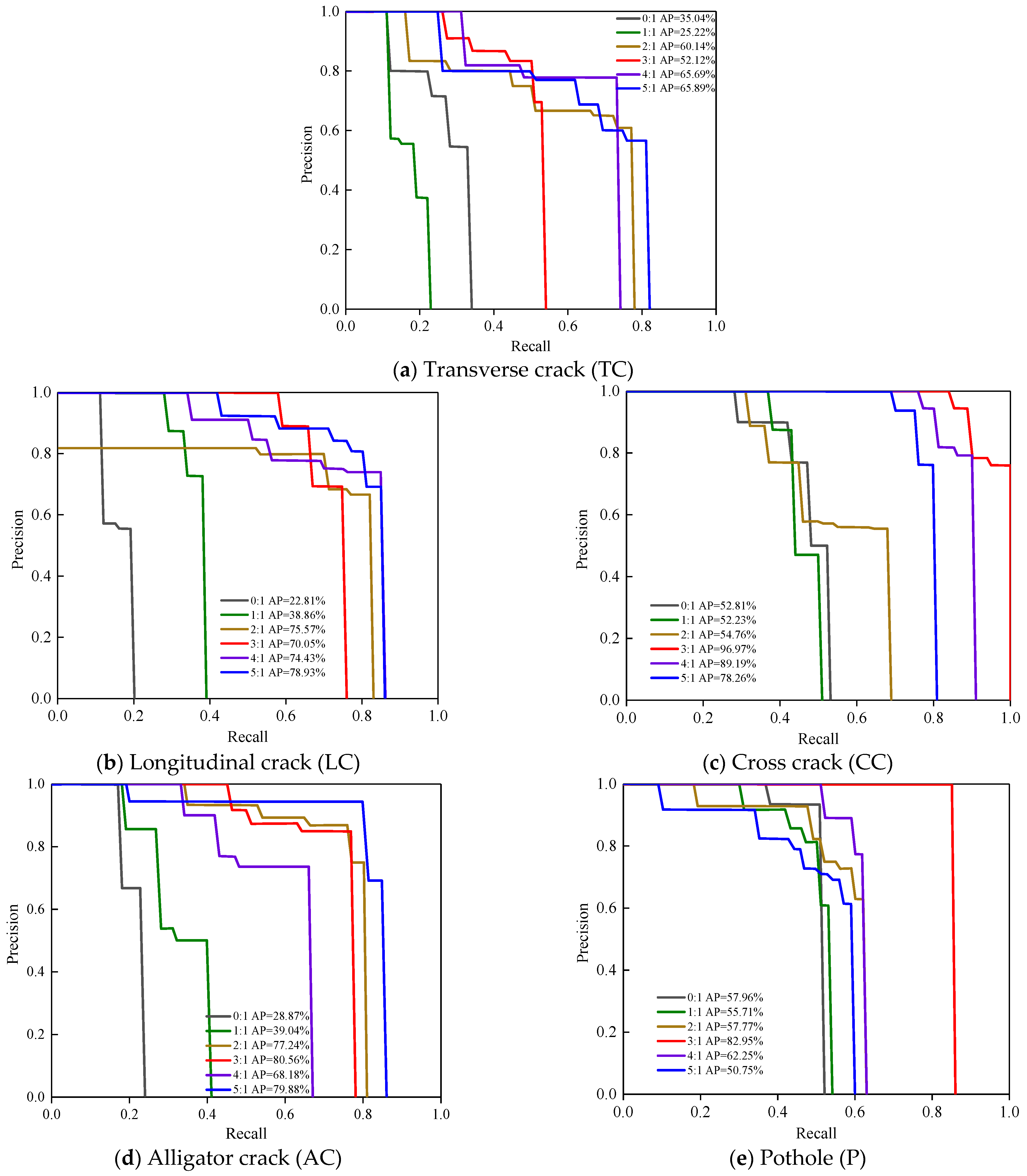
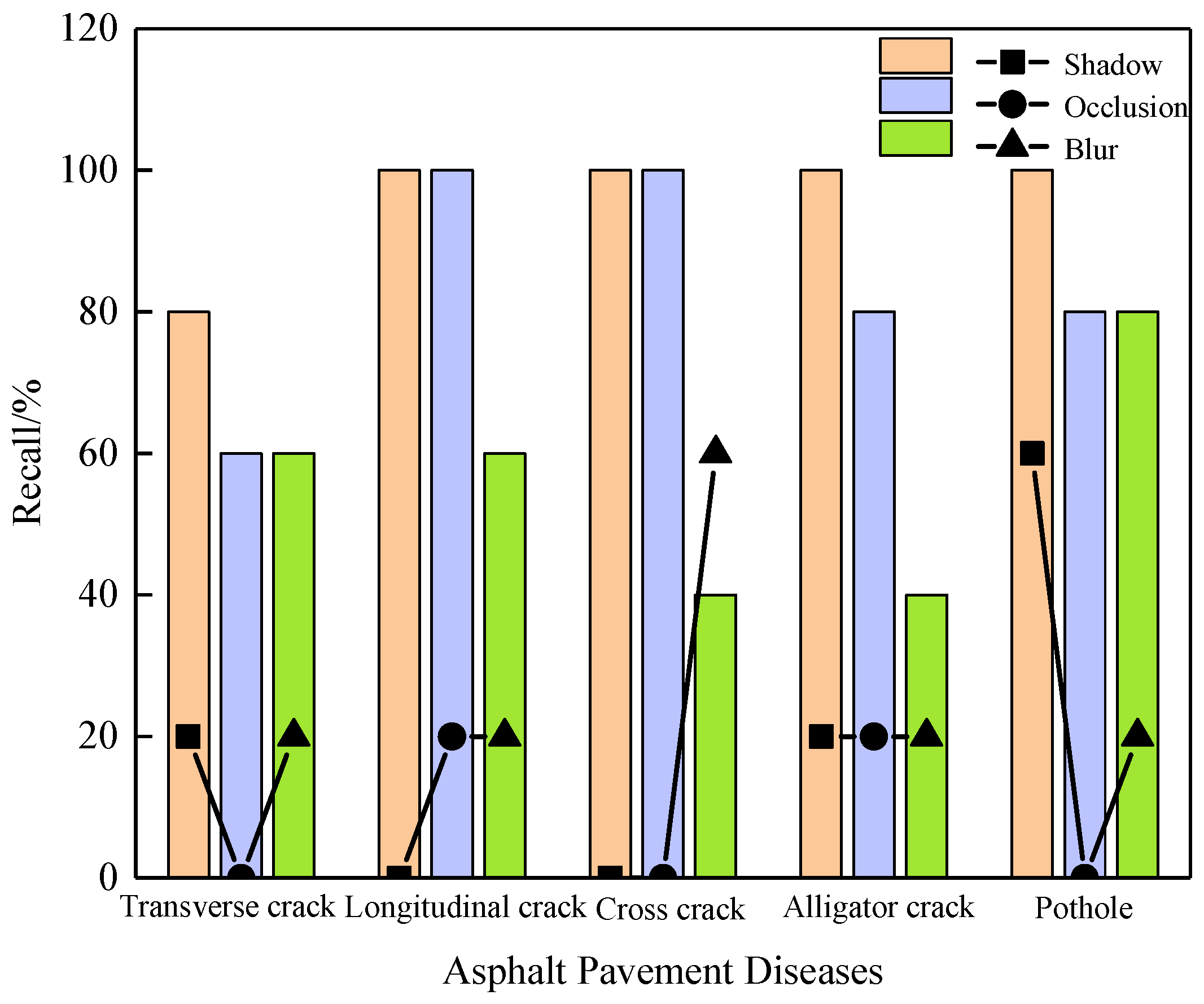



| Parameter Setting | ||||||
|---|---|---|---|---|---|---|
| Camera parameters | Image sensors | Maximum resolution (pixels) | Photo format | Shutter speed | Focal length | ISO range |
| 1-inch CMOS; 20 million effective pixels (20.48 million total pixels) | 5472 × 3648 (3:2) | JPEG | 8 − 1/8000 s | 35 mm | 100–3200 (Automatic) 100–6400 (manual) | |
| Flight parameters | Flight height (m) | Flight speed (m/s) | Positive overlap rate | Lateral overlap rate | Shooting angles | Output resolution |
| 25 | 2 | 80% | 75% | −90° | 5472 × 3648 (3:2) | |
| Integrated Dataset | Virtual-to-Real Ratio | |||||
|---|---|---|---|---|---|---|
| 0:1 | 1:1 | 2:1 | 3:1 | 4:1 | 5:1 | |
| Training set/image | 0 | 100 | 200 | 300 | 400 | 500 |
| 100 | 100 | 100 | 100 | 100 | 100 | |
| Test set/image | 100 | 100 | 100 | 100 | 100 | 100 |
| Total set/image | 200 | 300 | 400 | 500 | 600 | 700 |
| Network Structure | Initial Learning Rate | Exponential Decay Rate | Parameter Update Algorithm | Batch Size | Epoch |
|---|---|---|---|---|---|
| YOLOv5 | 0.00125 | 0.9 | Adam, β = 0.9 | 8 | 1000 |
| Transverse Crack (TC) | Longitudinal Crack (LC) | Cross Crack (CC) | Alligator Crack (AC) | Pothole (P) | ||
|---|---|---|---|---|---|---|
| Measured dataset (0:1) | 35.04 | 22.81 | 52.81 | 28.87 | 57.96 | 39.50 |
| Traditional data augmentation (3:1) | 50.49 | 36.77 | 54.07 | 32.2 | 60.95 | 46.90 |
| Integrated dataset (3:1) | 52.12 | 70.05 | 96.97 | 80.56 | 82.95 | 76.53 |
| Integrated Dataset | Number of Images | ||||
|---|---|---|---|---|---|
| Training set Virtual-to real (3:1) | Real images | 25 | 50 | 75 | 100 |
| Virtual images | 75 | 150 | 225 | 300 | |
| Test set | 100 | 100 | 100 | 100 | |
| Total set | 200 | 300 | 400 | 500 | |
| MAP% | 49.85 | 50.33 | 76.19 | 76.53 | |
Disclaimer/Publisher’s Note: The statements, opinions and data contained in all publications are solely those of the individual author(s) and contributor(s) and not of MDPI and/or the editor(s). MDPI and/or the editor(s) disclaim responsibility for any injury to people or property resulting from any ideas, methods, instructions or products referred to in the content. |
© 2023 by the authors. Licensee MDPI, Basel, Switzerland. This article is an open access article distributed under the terms and conditions of the Creative Commons Attribution (CC BY) license (https://creativecommons.org/licenses/by/4.0/).
Share and Cite
Wang, W.; Xu, X.; Peng, J.; Hu, W.; Wu, D. Fine-Grained Detection of Pavement Distress Based on Integrated Data Using Digital Twin. Appl. Sci. 2023, 13, 4549. https://doi.org/10.3390/app13074549
Wang W, Xu X, Peng J, Hu W, Wu D. Fine-Grained Detection of Pavement Distress Based on Integrated Data Using Digital Twin. Applied Sciences. 2023; 13(7):4549. https://doi.org/10.3390/app13074549
Chicago/Turabian StyleWang, Weidong, Xinyue Xu, Jun Peng, Wenbo Hu, and Dingze Wu. 2023. "Fine-Grained Detection of Pavement Distress Based on Integrated Data Using Digital Twin" Applied Sciences 13, no. 7: 4549. https://doi.org/10.3390/app13074549
APA StyleWang, W., Xu, X., Peng, J., Hu, W., & Wu, D. (2023). Fine-Grained Detection of Pavement Distress Based on Integrated Data Using Digital Twin. Applied Sciences, 13(7), 4549. https://doi.org/10.3390/app13074549





